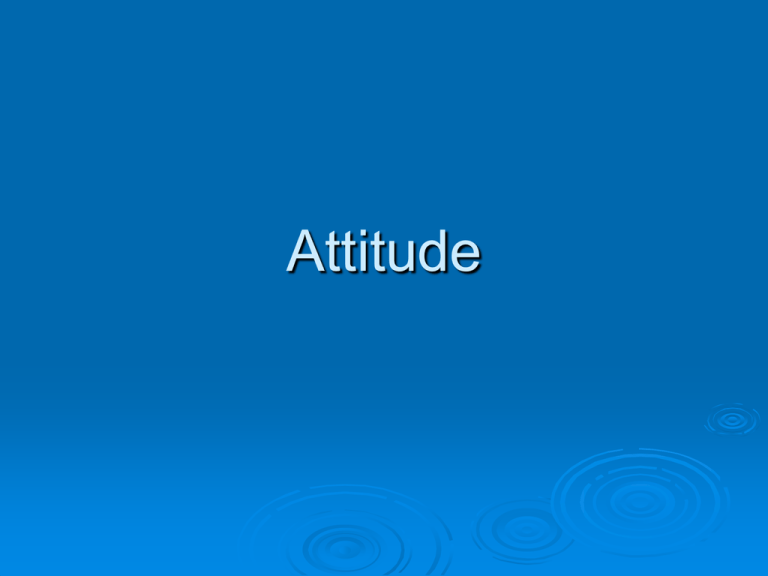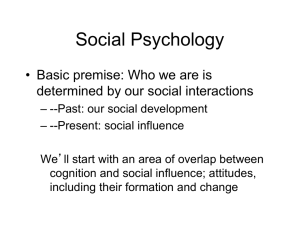Attitude
advertisement

Attitude Attitude vs. Belief Belief is a thought (cognition) about something Raw fish is bad Exercise is important Attitude adds two components: ABCs Affective: evaluation, emotion Behavioral: tendency to take action Cognitive: belief or thoughts Components Affective: I hate raw fish and sushi I enjoy exercise Behavioral I won’t eat sushi I will exercise regularly Cognitive Raw fish is bad Exercise is good Consistency We always want our ABCs to agree What Behavior will shape our attitude What if we don’t have an attitude? if our ABCs are inconsistent? Caveats Attitudes Explicit attitude Implicit attitude Involuntary, uncontrollable, often unconscious IAT Attitudes toward groups Prejudice Stereotypes Affective component Hostile or negative attitude toward people just because they are a group member Cognitive component Generalization in which identical characteristics are assigned to all members Discrimination Behavioral component Unjustified negative or harmful action toward a group member because of their membership Prejudice in the classroom Jane Elliott Prejudice can be taught Told students blue-eyed people were better than brown-eyed people Brown-eyed children had to wear collars and sit in the back of class Over the course of one day: brown eyed children became self-conscious, depressed, and demoralized Next day: Elliott switched the stereotypes about eyecolor (brown=good) Brown-eyed kids exacted their revenge Why are stereotypes maintained? Illusory correlation Out-group homogeneity effect See correlations where they don’t exist Remember confirmatory examples more Example: Cheerleaders are outgoing Us vs. them “All ______ are alike” In-group bias Positive feelings for people who are part of our ingroup Alumni, state residency Fundamental Attribution Error Interpret behavior as a characteristic of the individual rather than the situation Do not take into account the situation Person unemployed is a bad worker Bush caused war Jeopardy player is really smart Maintain stereotypes: Attribute confirmatory examples to the individual Ignore/attribute to the situation examples which don’t fit or stereotype Persuasion Yale Attitude Change Hovland, 1953 The effectiveness of communication depends on who says what to whom. Who: The persuader or source • Credibility (expertise, knowledge) • Attractiveness Persuasion What: The message • One- vs. two-sided messages • Blatantly persuasive • Primacy vs. recency Depends on when decision is made • Fear arousing To whom: The recipient • Distraction • Intelligence • Age Persuasive techniques Foot in the door Door in the face Reciprocity—create an obligation Low-ball—obtain commitment then up the price Sweeten the deal Exclusivity Prestige Heider’s Balance Theory We want to maintain consistency among our attitudes Prefer to agree with someone I like Disagree with someone I dislike Object + Object + Self -- Other + + Self Other -- Balance Theory What if my attitudes are imbalanced? Object -- Object + Self + Other Self + + Other -- Change beliefs about the object Change beliefs about the person • Change whichever is easier








